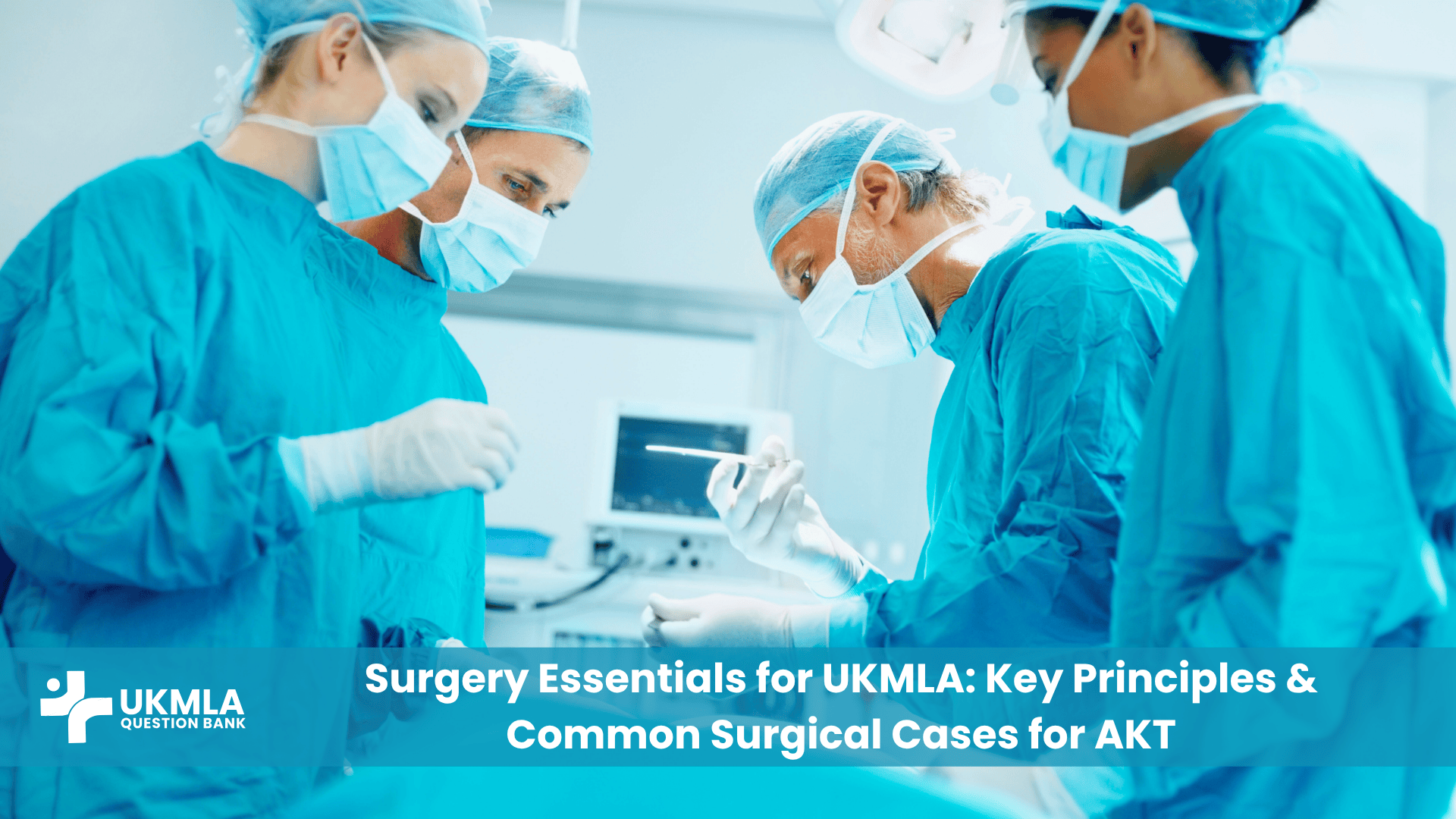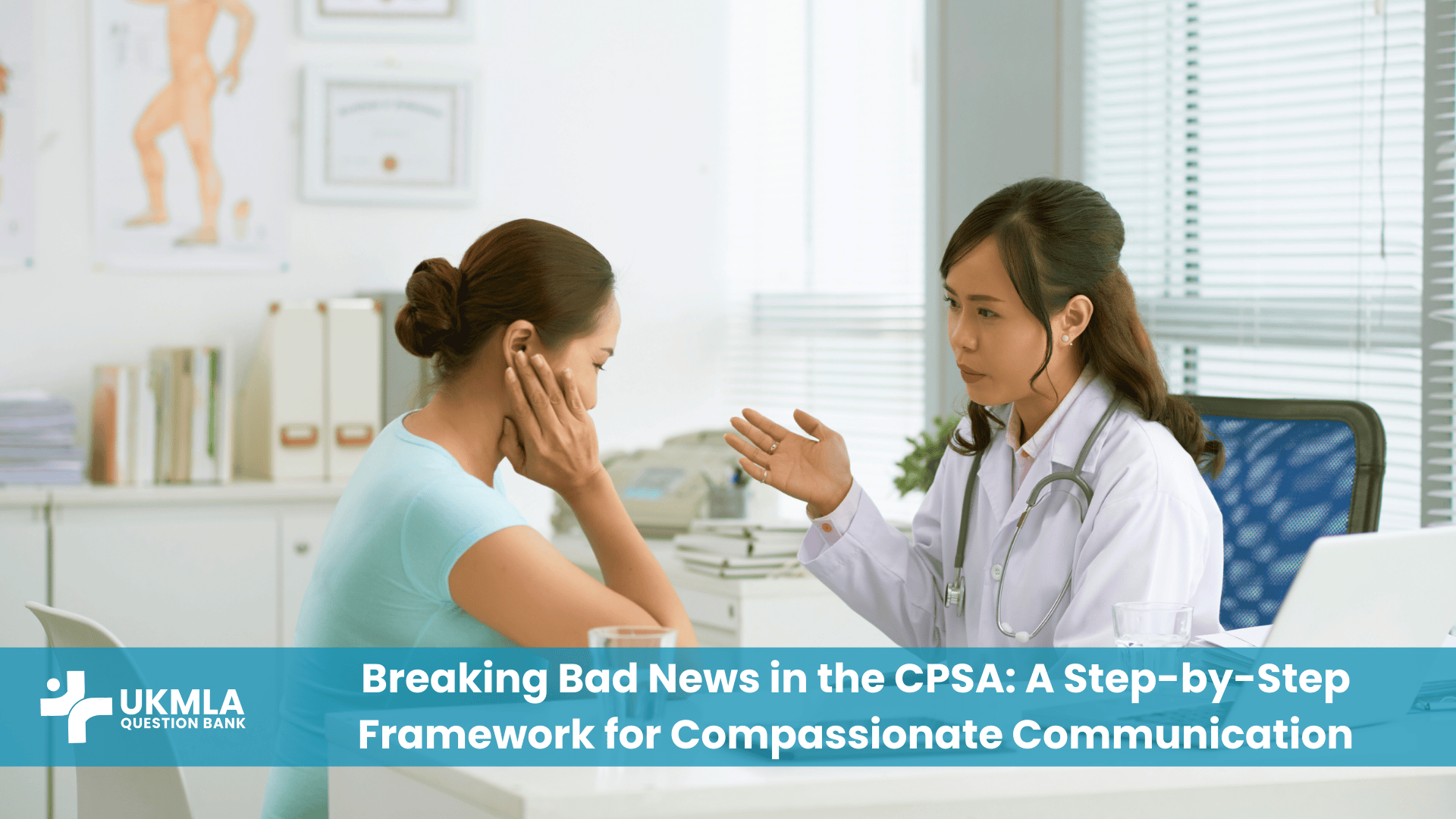Introduction
Mastering the common surgical cases for UKMLA AKT can feel like a monumental task. The breadth of knowledge required, from fundamental physiological principles to the nuanced management of acute presentations, is vast. Many students feel overwhelmed, unsure of where to focus their revision for maximum impact. This guide is designed to solve that problem. We will break down the core surgical principles you absolutely must know and then walk through the 15 most frequently encountered surgical scenarios, providing a clear, high-yield framework for your UKMLA preparation.
This is more than just a list of conditions; it’s a strategic approach to help you deconstruct clinical vignettes, recognise red flags, and confidently apply management plans that will score you points on exam day.
Table of Contents
ToggleUnderstanding Core Surgical Principles for the UKMLA
Before diving into specific conditions, a firm grasp of the universal principles of surgery is essential. These concepts form the bedrock of safe and effective surgical practice and are frequently tested in the UKMLA, often through questions assessing professionalism and patient safety. Understanding these principles demonstrates a level of clinical maturity that examiners look for.
The Structured Approach: Preoperative Assessment & Optimisation
Every surgical journey begins long before the patient reaches the operating theatre. A thorough preoperative assessment is crucial for identifying risk factors and optimising the patient’s condition to withstand the physiological stress of surgery. This involves a detailed history, a focused physical examination, and targeted investigations. Your role often involves recognising which patients need further workup. Key areas include cardiovascular and respiratory fitness, nutritional status, and medication review (e.g., stopping anticoagulants). A comprehensive UKMLA clinical examination is fundamental to this process, allowing you to spot subtle signs that could impact surgical outcomes.
Informed Consent and Patient Safety: The GMC Framework
Informed consent is not just a form; it is a critical process of communication. As a junior doctor, you must understand the principles underpinning it. The patient must be given all relevant information about their condition, the proposed procedure (including benefits and risks), alternative treatments (including doing nothing), and have the opportunity to ask questions.
According to the General Medical Council (GMC), the exchange of information between a doctor and patient is central to good decision making. You must give patients the information they want or need in a way they can understand.
This process must be documented clearly. For a definitive understanding, you should always refer to the official GMC guidance on decision making and consent. This area is a cornerstone of UKMLA professionalism and patient safety and is guaranteed to be tested.
Fundamental Intraoperative Concepts
While you won’t be performing the surgery, you need to understand the key concepts. This includes knowledge of anaesthesia (general vs. regional), patient positioning to avoid nerve injury, diathermy principles, and aseptic technique (the “sterile field”). A critical concept is the WHO Surgical Safety Checklist, which has three phases: “Sign In” (before anaesthesia), “Time Out” (before skin incision), and “Sign Out” (before the patient leaves the theatre). Understanding the purpose of this checklist is a key patient safety requirement.
Postoperative Care: Managing Complications and Recovery
Your role as a junior doctor is often most prominent in the postoperative period. You will be responsible for monitoring patients, managing common issues, and escalating concerns. Key areas of focus include:
Pain management: Using a multimodal approach (e.g., paracetamol, NSAIDs, opioids).
Fluid balance: Meticulous monitoring of input and output.
VTE prophylaxis: Prescribing appropriate chemical and/or mechanical prophylaxis.
Early recognition of complications: Such as surgical site infection (SSI), haemorrhage, ileus, and atelectasis.
A structured “5 W’s” approach can help diagnose postoperative fever: Wind (atelectasis, pneumonia), Water (UTI), Wound (infection), Walking (DVT/PE), and Wonder drugs (drug-induced fever).
Mastering the 15 Common Surgical Cases for UKMLA AKT
This section covers the high-yield surgical presentations you are most likely to encounter. For many of these, the initial management falls under the umbrella of UKMLA emergency medicine essentials, highlighting the significant overlap between specialties.
1. Acute Appendicitis
Presentation: Classically starts with vague central abdominal pain that migrates to the right iliac fossa (RIF). Associated with anorexia, nausea, and low-grade fever. On examination, look for tenderness at McBurney’s point, guarding, and rebound tenderness.
Diagnosis: Primarily clinical. Raised inflammatory markers (WCC, CRP) are common. A CT scan is often used in atypical cases or to rule out other pathology, especially in older adults and women of childbearing age.
Management: IV fluids, analgesia, antiemetics, and prompt surgical referral for laparoscopic appendicectomy.
2. Cholecystitis & Biliary Colic
Presentation: Biliary colic is intermittent, severe right upper quadrant (RUQ) pain, often post-prandial, lasting less than 6 hours. Cholecystitis is constant RUQ pain (>6 hours), fever, and a positive Murphy’s sign (inspiratory arrest on RUQ palpation).
Diagnosis: Ultrasound is the investigation of choice, showing gallstones, a thickened gallbladder wall, and pericholecystic fluid. Liver function tests may show a cholestatic picture.
Management: Follow the latest NICE guidance on gallstone disease. Initial management includes IV fluids, analgesia, and IV antibiotics. Definitive treatment is laparoscopic cholecystectomy, ideally within the same admission.
3. Bowel Obstruction (Small & Large)
Presentation: Cardinal features are colicky abdominal pain, vomiting (early and profuse in small bowel, late in large bowel), abdominal distension, and absolute constipation (failure to pass flatus or faeces).
Diagnosis: An erect chest X-ray may show air under the diaphragm (if perforated). An abdominal X-ray will show dilated loops of bowel. CT scan with contrast is the gold standard to identify the level and cause of obstruction.
Management: The mantra is “drip and suck”: IV fluids (the “drip”) and a nasogastric (NG) tube for decompression (the “suck”). Urgent surgical review is mandatory.
Table 1: Differentiating Small vs. Large Bowel Obstruction
| Feature | Small Bowel Obstruction (SBO) | Large Bowel Obstruction (LBO) |
|---|---|---|
| Common Causes | Adhesions (post-surgery), Hernias | Colorectal Cancer, Diverticular Stricture, Volvulus |
| Pain | Central, colicky | Lower abdomen, colicky |
| Vomiting | Early, profuse | Late, may be faeculent |
| Distension | Minimal | Pronounced |
| Constipation | Late feature | Early feature (absolute) |
| AXR Findings | Valvulae conniventes (lines cross full bowel width) | Haustra (lines do not cross full bowel width) |
4. Inguinal & Femoral Hernias
Presentation: A lump in the groin. Inguinal hernias are superior and medial to the pubic tubercle. Femoral hernias are inferior and lateral. Femoral hernias are more common in women and have a high risk of strangulation.
Diagnosis: Usually clinical. An ultrasound can be used if there is diagnostic uncertainty.
Management: All femoral hernias and symptomatic inguinal hernias require elective surgical repair. An irreducible, tender, and painful hernia is a surgical emergency (strangulation) requiring immediate admission and operation.
5. Acute Diverticulitis
Presentation: Constant, sharp pain in the left iliac fossa (LIF), fever, and a change in bowel habit.
Diagnosis: Raised inflammatory markers. CT scan with contrast is the gold standard to confirm the diagnosis and look for complications (abscess, perforation, fistula).
Management: Uncomplicated diverticulitis can be managed in the community with oral antibiotics. Complicated cases require hospital admission, IV antibiotics, and potentially percutaneous drainage of an abscess or surgery.
6. Perforated Peptic Ulcer
Presentation: Sudden onset, severe, generalised abdominal pain. The patient lies completely still. Examination reveals a rigid, “board-like” abdomen (peritonism).
Diagnosis: An erect chest X-ray is the crucial first investigation, looking for free air under the diaphragm (pneumoperitoneum).
Management: This is a surgical emergency. Immediate resuscitation (A-to-E approach), IV fluids, broad-spectrum antibiotics, analgesia, and urgent surgical referral for laparotomy and repair (e.g., Graham patch).
7. Acute Pancreatitis
Presentation: Severe, constant epigastric pain radiating to the back. Often associated with nausea and vomiting.
Diagnosis: Requires two of the following three criteria: 1) characteristic epigastric pain, 2) amylase or lipase >3 times the upper limit of normal, 3) characteristic findings on imaging (CT).
Management: Supportive care is key: aggressive IV fluid resuscitation, analgesia, and nutritional support. The severity is assessed using the Glasgow score.
Table 2: Modified Glasgow Score for Pancreatitis Severity
| Mnemonic | Parameter | Value |
|---|---|---|
| P | PaO2 | < 8 kPa |
| A | Age | > 55 years |
| N | Neutrophils (WCC) | > 15 x 10⁹/L |
| C | Calcium | < 2 mmol/L |
| R | Renal function (Urea) | > 16 mmol/L |
| E | Enzymes (LDH) | > 600 iu/L |
| A | Albumin | < 32 g/L |
| S | Sugar (Glucose) | > 10 mmol/L |
| A score of ≥3 within 48 hours indicates severe pancreatitis and warrants HDU/ICU consideration. | ||
8. Abdominal Aortic Aneurysm (AAA)
Presentation: Often asymptomatic and found incidentally. A ruptured AAA presents with sudden, severe central abdominal or back pain, haemodynamic instability (hypotension, tachycardia), and a pulsatile, expansile abdominal mass.
Diagnosis: Ultrasound is used for screening and monitoring. In a haemodynamically unstable patient with suspected rupture, the diagnosis is clinical, and they should go straight to theatre. A stable patient can have a CT angiogram.
Management: Elective repair (open or endovascular) is considered when the aneurysm is >5.5cm. A ruptured AAA is a dire emergency requiring immediate resuscitation and transfer to a vascular centre for emergency surgery.
9. Peripheral Arterial Disease (PAD)
Presentation: Intermittent claudication (cramping leg pain on exertion, relieved by rest). Progresses to rest pain (especially at night), ulceration, and gangrene. Look for absent pulses, cold, pale skin, and hair loss.
Diagnosis: Ankle-Brachial Pressure Index (ABPI). A value <0.9 is diagnostic of PAD. <0.5 indicates critical limb ischaemia.
Management: Conservative management includes smoking cessation, exercise, and medical therapy (statin, clopidogrel). Surgical options include angioplasty, stenting, or bypass surgery.
10. Deep Vein Thrombosis (DVT)
Presentation: Unilateral, painful, swollen, red, and warm calf.
Diagnosis: Use the Wells score to stratify risk. A D-dimer test can help rule out DVT in ‘unlikely’ patients. A Doppler ultrasound of the leg is the definitive diagnostic test.
Management: Therapeutic anticoagulation (e.g., with a DOAC like apixaban or rivaroxaban) for at least 3-6 months. A massive DVT causing limb ischaemia (phlegmasia cerulea dolens) is a surgical emergency.
11. Testicular Torsion
Presentation: Sudden onset, severe, unilateral testicular pain, often in an adolescent. The testicle may be high-riding and horizontal. The cremasteric reflex is absent.
Diagnosis: This is a clinical diagnosis. Do not delay for imaging.
Management: This is a time-critical surgical emergency. Immediate surgical exploration is required. The aim is to de-tort the testis and perform a bilateral orchidopexy (fixing both testes) to prevent recurrence. There is a 4-6 hour window before irreversible ischaemic damage occurs.
12. Acute Urinary Retention
Presentation: Inability to pass urine, associated with severe suprapubic pain. On examination, a palpable, dull-to-percuss bladder is present.
Diagnosis: Clinical. A post-void bladder scan will show a large residual volume.
Management: Immediate bladder decompression with a urethral catheter. Investigate the underlying cause, most commonly benign prostatic hyperplasia (BPH) in men.
13. Neck of Femur Fracture
Presentation: Typically an elderly patient who has fallen. They present with hip pain and inability to weight-bear. The affected leg is characteristically shortened and externally rotated.
Diagnosis: AP and lateral X-rays of the hip.
Management: Analgesia (including nerve blocks), VTE prophylaxis, and prompt surgical fixation. The type of surgery depends on whether the fracture is displaced (requiring hemiarthroplasty or total hip replacement) or undisplaced (internal fixation).
14. Compartment Syndrome
Presentation: Most common after a long bone fracture (especially the tibia). The key feature is pain out of proportion to the injury, unrelieved by analgesia. The limb is tense and swollen. Late signs include paraesthesia and pulselessness.
Diagnosis: Clinical. Do not wait for late signs. Compartment pressure measurement can be used but should not delay treatment.
Management: A limb-threatening emergency. Immediate, urgent fasciotomy is required to release the pressure in the fascial compartments.
15. Breast Abscess
Presentation: A painful, tender, fluctuant mass in the breast, often in a lactating woman, with overlying skin erythema. Associated with fever and malaise.
Diagnosis: Clinical, confirmed with a breast ultrasound.
Management: Treatment involves antibiotics and drainage, which can be done via needle aspiration or surgical incision and drainage.
How to Tackle Surgical Scenarios in the UKMLA AKT
Knowing the conditions is only half the battle. You need a strategy to apply that knowledge under exam pressure. Success in answering questions about common surgical cases for UKMLA AKT often comes down to a structured approach.
Deconstructing the Clinical Vignette: Identifying Key Information
Read the question stem carefully. Pay attention to:
Patient demographics: Age and gender can significantly alter the differential diagnosis.
Timing and onset: Was the pain sudden (perforation, torsion) or gradual (appendicitis, diverticulitis)?
Key descriptors: Words like “radiating to the back” (pancreatitis), “colicky” (obstruction), or “tearing” (AAA dissection) are classic clues.
Vital signs: Tachycardia and hypotension are red flags for sepsis or haemorrhage.
Recognising Red Flag Symptoms in Surgical Presentations
Certain signs and symptoms demand immediate attention and a higher index of suspicion. These include:
Haemodynamic instability (hypotension, tachycardia)
Peritonism (rigid abdomen, guarding, rebound tenderness)
Pulsatile abdominal mass
Pain out of proportion to the clinical findings
Sudden onset, “thunderclap” pain
Applying a Stepwise Management Plan (Investigate, Resuscitate, Refer)
For any acutely unwell surgical patient, your thinking should be structured. This is one of the most effective proven strategies for a high AKT score.
Blockquote: In nearly every acute surgical scenario, your immediate priorities can be simplified to a three-step mantra: Resuscitate, Investigate, Refer. Start life-saving measures based on an A-to-E assessment, order appropriate initial tests, and get the surgeons involved early.
This systematic approach ensures you don’t miss critical immediate steps while also considering the definitive management plan.
Frequently Asked Questions (FAQ) Surgery Essentials for UKMLA
An indirect inguinal hernia passes through the deep inguinal ring, lateral to the inferior epigastric vessels. A direct inguinal hernia pushes through a weakness in the posterior wall of the inguinal canal (Hesselbach’s triangle), medial to the inferior epigastric vessels.
It means managing a condition without surgery. This typically involves a “watch and wait” approach with active monitoring, analgesia, fluid support, and sometimes antibiotics (e.g., for uncomplicated diverticulitis). It is not a passive process.
Torsion has a sudden, severe onset, a high-riding horizontal testis, and an absent cremasteric reflex. Epididymo-orchitis has a more gradual onset, may be associated with urinary symptoms, and pain is often relieved by elevating the testis (Prehn’s sign). If in any doubt, treat it as torsion.
It involves assessing patient-related factors (e.g., age, obesity, cancer, previous VTE) and procedure-related factors (e.g., type and duration of surgery, expected immobility). This helps determine the need for prophylaxis.
Questions may involve resource allocation, breaking bad news, dealing with colleagues who may be underperforming, or managing patient complaints. The principles of beneficence, non-maleficence, autonomy, and justice are key.
Prophylactic antibiotics are not routinely recommended in mild or moderate acute pancreatitis. They are reserved for cases where there is evidence of infected necrosis (confirmed on CT) or another source of infection.
Key differentials include ectopic pregnancy or ovarian torsion in women (always do a pregnancy test), Meckel’s diverticulum in children, and ureteric colic (pain may radiate to the groin, look for haematuria).
UC affects only the colon, is continuous, and surgery (panproctocolectomy) can be curative. Crohn’s can affect any part of the GI tract (“gum to bum”), has “skip lesions,” and surgery is not curative, reserved only for complications like strictures or fistulae.
Look at the pH, PaCO2, and Bicarbonate/Base Excess. A high lactate and metabolic acidosis in a patient with abdominal pain is a major red flag for bowel ischaemia or severe sepsis.
Use a structured A-to-E approach for initial resuscitation. Then, think in terms of Investigations (Bloods, Imaging), immediate management (IV fluids, analgesia, antibiotics, NG tube), and definitive management (conservative vs. surgical, and which procedure).
Conclusion:
Successfully navigating surgery questions in the UKMLA AKT hinges on a dual strategy: a solid understanding of core principles and pattern recognition of the common surgical cases for UKMLA AKT. Focus on the structured A-to-E approach for every acute patient, never forget the importance of consent and patient safety, and learn to identify red flags quickly.
By mastering the 15 conditions outlined in this guide and applying a systematic approach to every clinical scenario, you will build the confidence and competence needed to excel. Use this framework as the foundation of your revision, and you will be well-equipped to handle whatever the exam throws at you.




